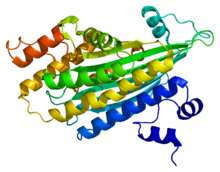コプロポルフィリノーゲンオキシダーゼ
(コプロポルフィリノーゲン酸化酵素から転送)
コプロポルフィリノーゲンオキシダーゼ(coproporphyrinogen oxidase)は、ヒトのCPOX遺伝子にコードされている酵素である[1][2][3]。この酵素はポルフィリン代謝の6番目の反応に関与し、コプロポルフィリノーゲンIIIをプロトポルフィリノーゲンIXに変換する。
-
コプロポルフィリノーゲンIII
-
プロトポルフィリノーゲンIX
脚注
編集- ^ Lamoril J, Martasek P, Deybach JC, Da Silva V, Grandchamp B, Nordmann Y (Jun 1995). “A molecular defect in coproporphyrinogen oxidase gene causing harderoporphyria, a variant form of hereditary coproporphyria”. Hum Mol Genet 4 (2): 275-8. PMID 7757079.
- ^ Kohno H, Furukawa T, Yoshinaga T, Tokunaga R, Taketani S (Nov 1993). “Coproporphyrinogen oxidase. Purification, molecular cloning, and induction of mRNA during erythroid differentiation”. J Biol Chem 268 (28): 21359-63. PMID 8407975.
- ^ “Entrez Gene: CPOX coproporphyrinogen oxidase”. 22 February 2008閲覧。
参考文献
編集- Fujita H, Kondo M, Taketani S, et al. (1995). “Characterization and expression of cDNA encoding coproporphyrinogen oxidase from a patient with hereditary coproporphyria.”. Hum. Mol. Genet. 3 (10): 1807–10. doi:10.1093/hmg/3.10.1807. PMID 7849704.
- Cacheux V, Martasek P, Fougerousse F, et al. (1994). “Localization of the human coproporphyrinogen oxidase gene to chromosome band 3q12.”. Hum. Genet. 94 (5): 557–9. doi:10.1007/BF00211026. PMID 7959694.
- Delfau-Larue MH, Martasek P, Grandchamp B (1995). “Coproporphyrinogen oxidase: gene organization and description of a mutation leading to exon 6 skipping.”. Hum. Mol. Genet. 3 (8): 1325–30. doi:10.1093/hmg/3.8.1325. PMID 7987309.
- Martasek P, Nordmann Y, Grandchamp B (1994). “Homozygous hereditary coproporphyria caused by an arginine to tryptophane substitution in coproporphyrinogen oxidase and common intragenic polymorphisms.”. Hum. Mol. Genet. 3 (3): 477–80. doi:10.1093/hmg/3.3.477. PMID 8012360.
- Maruyama K, Sugano S (1994). “Oligo-capping: a simple method to replace the cap structure of eukaryotic mRNAs with oligoribonucleotides.”. Gene 138 (1-2): 171–4. doi:10.1016/0378-1119(94)90802-8. PMID 8125298.
- Martasek P, Camadro JM, Delfau-Larue MH, et al. (1994). “Molecular cloning, sequencing, and functional expression of a cDNA encoding human coproporphyrinogen oxidase.”. Proc. Natl. Acad. Sci. U.S.A. 91 (8): 3024–8. doi:10.1073/pnas.91.8.3024. PMID 8159699.
- Taketani S, Kohno H, Furukawa T, et al. (1994). “Molecular cloning, sequencing and expression of cDNA encoding human coproporphyrinogen oxidase.”. Biochim. Biophys. Acta 1183 (3): 547–9. doi:10.1016/0005-2728(94)90083-3. PMID 8286403.
- Lamoril J, Deybach JC, Puy H, et al. (1997). “Three novel mutations in the coproporphyrinogen oxidase gene.”. Hum. Mutat. 9 (1): 78–80. doi:10.1002/(SICI)1098-1004(1997)9:1<78::AID-HUMU17>3.0.CO;2-M. PMID 8990017.
- Daimon M, Gojyou E, Sugawara M, et al. (1997). “A novel missense mutation in exon 4 of the human coproporphyrinogen oxidase gene in two patients with hereditary coproporphyria.”. Hum. Genet. 99 (2): 199–201. doi:10.1007/s004390050338. PMID 9048920.
- Schreiber WE, Zhang X, Senz J, Jamani A (1997). “Hereditary coproporphyria: exon screening by heteroduplex analysis detects three novel mutations in the coproporphyrinogen oxidase gene.”. Hum. Mutat. 10 (3): 196–200. doi:10.1002/(SICI)1098-1004(1997)10:3<196::AID-HUMU3>3.0.CO;2-H. PMID 9298818.
- Suzuki Y, Yoshitomo-Nakagawa K, Maruyama K, et al. (1997). “Construction and characterization of a full length-enriched and a 5'-end-enriched cDNA library.”. Gene 200 (1-2): 149–56. doi:10.1016/S0378-1119(97)00411-3. PMID 9373149.
- Lamoril J, Puy H, Gouya L, et al. (1998). “Neonatal hemolytic anemia due to inherited harderoporphyria: clinical characteristics and molecular basis.”. Blood 91 (4): 1453–7. PMID 9454777.
- Susa S, Daimon M, Kondo H, et al. (1999). “Identification of a novel mutation of the CPO gene in a Japanese hereditary coproporphyria family.”. Am. J. Med. Genet. 80 (3): 204–6. doi:10.1002/(SICI)1096-8628(19981116)80:3<204::AID-AJMG4>3.0.CO;2-G. PMID 9843038.
- Rosipal R, Lamoril J, Puy H, et al. (1999). “Systematic analysis of coproporphyrinogen oxidase gene defects in hereditary coproporphyria and mutation update.”. Hum. Mutat. 13 (1): 44–53. doi:10.1002/(SICI)1098-1004(1999)13:1<44::AID-HUMU5>3.0.CO;2-Q. PMID 9888388.
- Taketani S, Furukawa T, Furuyama K (2001). “Expression of coproporphyrinogen oxidase and synthesis of hemoglobin in human erythroleukemia K562 cells.”. Eur. J. Biochem. 268 (6): 1705–11. doi:10.1046/j.1432-1327.2001.02045.x. PMID 11248690.
- Lamoril J, Puy H, Whatley SD, et al. (2001). “Characterization of mutations in the CPO gene in British patients demonstrates absence of genotype-phenotype correlation and identifies relationship between hereditary coproporphyria and harderoporphyria.”. Am. J. Hum. Genet. 68 (5): 1130–8. doi:10.1086/320118. PMID 11309681.
- Elkon H, Don J, Melamed E, et al. (2003). “Mutant and wild-type alpha-synuclein interact with mitochondrial cytochrome C oxidase.”. J. Mol. Neurosci. 18 (3): 229–38. doi:10.1385/JMN:18:3:229. PMID 12059041.
- Wiman A, Floderus Y, Harper P (2002). “Two novel mutations and coexistence of the 991C>T and the 1339C>T mutation on a single allele in the coproporphyrinogen oxidase gene in Swedish patients with hereditary coproporphyria.”. J. Hum. Genet. 47 (8): 407–12. doi:10.1007/s100380200059. PMID 12181641.


